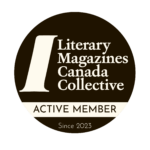Book Review: A knife so sharp its edge cannot be seen by Erin Noteboom
By John Vardon
It’s been a while since Erin Noteboom’s last book of poetry, eighteen years in fact. It’s not as if she and the muse of poetry were not on speaking terms as in the interim her poems have appeared in the anthologies Best Canadian Poetry (2018, 2020) and journals like Fiddlehead, Grain, The Malahat Review and, quite happily, TNQ. Then, of course, there are the four award- winning fantasy novels for young adult readers, written under the name of Erin Bow. Did I mention her memoir (The Mongoose Diaries, 2007). Last and the polar opposite of least, Noteboom admits in her “Acknowledgements” that this collection has been an on-and-off project for more than a decade. A knife so sharp its edge cannot be seen, one of Brick Book’s spring releases, rewards anticipation.
The collection is the first in which Noteboom’s two most consistent areas of professional and artistic interest intersect: science and poetry. Apart from the many other motivations that a poet is heir to, the book is the result of her revelation “that science is not off-limits as a subject of poetry,” to use her own words. This poems are well informed and well illumined by science, especially in the section entitled “skiagraphs,” an early term for X-rays. The poems here explore scientists’ first investigations into radiation and its gruesome and lasting effects, especially the painstaking efforts of the Curies to extract radium: “Forty tons of corrosive chemicals/Four hundred tons of water/pinprick by pinprick,/radium chloride—point one of a gram at last aglow/like jam on the windowsill.” Perhaps the most sadly beautiful poem in this section is “Radium Girls,” the story of the many female factory workers from 1917 to the early 1920s who became sick and died of radiation poisoning after they were told that the radium powder that they were using to paint self-illuminating clock dials was harmless, so much so that they could sharpen their brush ends by twisting them on their lips. The poem ends in heart-breaking fashion by focusing on three sisters, one whose hips break, another who loses both her teeth and her children, and a third who dies but is “lifted from her grave. Her skull made powder./Her long bones sliced to two-inch buttons…her dazzling bones can still expose an X-ray.” Poems about American atomic bomb testing round out this section, all of which remind me of what Noteboom says in “Quarks: An Exegesis” when she refers to “a model of nuclear physics that has so recently, troublingly and triumphantly been put to real use.”
Though allusions to science and scientists also appear throughout the collection, Noteboom writes about many other things in a variety of styles. Yet she calls this her “book of equations,” based on her sense that a metaphor is an equation because, in a sense, they both say “this is that.” To illustrate her point she’s uses a poetic equation from one of the poems in the section “too strong to stop, too sweet to lose,” a long poem published originally in TNQ: “the wind in green wheat = a scythe being sharpened.” The poem is actually a series of questions and answers, such as
What do we hope for?
For hope itself, for honey
at the bottom of bitter tea.
Though hope keeps pulling loads
that would break the hearts of horses.
In lifeboats we strain our eyes
for a white curl that might be either sail
or wave
Other equally remarkable poems in the collection are the eight ghazals, each beginning with lines from other poets, ranging from Lorna Crozier to Pablo Neruda; those in the section “poems with a movement toward the particular, one of which, “things that the dead have touched,” asks, “What shall we do with their socks, for instance,” with the fact that their “fingerprints evaporate…the voice demagnetizes/on the answer tape, the smell of skin/ lifts free of sweaters”; and the long poem that emphatically ends the collection, “how to write at the end of the world,” written for and performed on the stage for Home Truths, an International Women’s Day event, which advises, “Write the things you love.”
“To write the things you love” is a suitable way to describe this consistently strong collection. Clearly, Noteboom has heeded her own advice but I’d go further, borrowing a verb that she once used to describe her difficulty in trying to write a series of rune poems, by which she has been “enspelled.” As she is enspelled, so are we.
Photo by Zoran Borojevic on Unsplash
Read more

